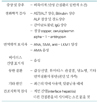Abstract
Autoimmune hepatitis is defined as an unresolving, predominantly periportal hepatitis of unknown etiology, usually with hypergammaglobulinemia and tissue autoantibodies, which is responsive to immunosuppressive therapy. Clinical manifestations, diagnostic criteria, differential diagnosis and treatment guideline have been described. In Korea the prevalence of autoimmune hepatitis seemed to be lower than that in western countries, but clinical features were similar, except for more severe female preponderance. According to recent clinical survey, mean age is 47.8, and MF ratio is 9:1. Mostly type 1, and had cirrhosis in 22% at the time of diagnosis. 16% of patients had associated immunologic disorders. The diagnosis is definite is 47.3%, and probable in 51.3%. 72% were treated with immunosuppressive therapy with remission rate of 70%. To understand the clinical features of autoimmune hepatitis adquately, nationalwide prospective clinical and epidemiological studies are needed urgently.
Figures and Tables
References
1. McFarlane IG. Definition and Classification of Autoimmune Hepatitis. Semin Liver Dis. 2002. 22:317–324.

3. Johnson PJ, McFarlane IG, Eddleton ALWF. The natural course and heterogenecity of autoimmune type chronic active hepatitis. Semin Liver Dis. 1991. 11:187–196.

4. McFarlane IG. Autoimmune hepatitis: diagnostic criteria, subclassification, and clinical features. Clin Liver Dis. 2002. 6:317–333.
6. Czaja AJ, Ireese DK. AASLD Practice guidelines. Diagnosis and treatment of autoimmune hepatitis. Hepatology. 2002. 36:479–497.
8. Carpenter HA, Czaja AJ. The role of histologic evaluation in the diagnosis and management of autoimmune hepatitis and its variants. Clin Liver Dis. 2002. 6:685–705.

9. Liu ZX, Kaplowitz N. Immune-mediated drug-induced liver disease. Clin Liver Dis. 2002. 6:755–774.

10. Alrarez F, Bianchi FB, Bianchi L, Burroughs AK, Cancado EL, Zeniya M, et al. International Autoimmune Hepatitis Group Report: review of criteria for diagnosis of autoimmune hepatitis. J Hepatol. 1999. 31:929–938.

12. Kaymakoglu S, Cakaloglu Y, Demir K, Turkoglu S, Badur S, Okten A, et al. Is severe cryptogenic chronic hepatitis similar to autoimmune hepatitis? J Hepatol. 1998. 28:78–83.

13. Beuers U. Hepatic overlap syndrome. J Hepatol. 2005. 42:S93–S99.
15. Czaja AJ, Rokela J, Luderig J. Features reflective of early prognosis in corticosteroid-treated severe autoimmune chronic active hepatitis. Gastroenterology. 1988. 95:448–453.

16. Ahmed M, Mutimer D, Hathaway M, Hubscher S, McMaster P, Elias E. Liver Transplantation for autoimmune hepatits; a 12-year experience. Transplantation Proc. 1997. 29:496.




 PDF
PDF ePub
ePub Citation
Citation Print
Print










 XML Download
XML Download